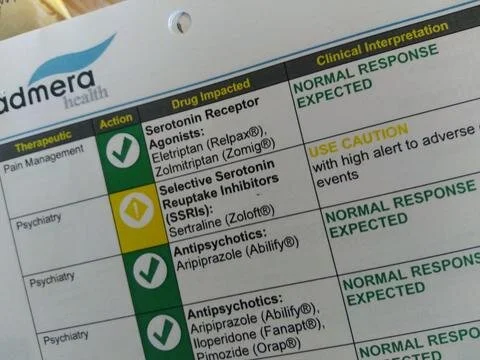TMS Woke Me Up!
This past summer I had a crash (aka relapse) that only lasted about two and a half weeks homebound, with three months of hard work to rebuild. After finally being advised not to work by both my mental health counselor and medical doctor; I gave in. This meant addressing and accepting a “new life” of not being part of the family equation to earn an income. With that came the sadness of breaking up with “ideas or past dreams” I carried for myself. It also meant having to address the anxiety attacks that were quite literally creeping up my body.
For me, the anxiety had always been more of an issue than the depression. Depression is real, and I have tackled it post-partum. I can identify and give myself some grace when my heart is sad, mourning things I need to release. However, anxiety has been a plague I have carried since childhood. I never knew what it was, but it scared me. I learned ways to avoid it and life continued. My biggest trigger was death. As an adult, I have accepted death, but my newest anxiety comes from triggers related to my illness. Does a cough mean I am about to have a crash? What if carrying this family financially is too much for my husband, all the what if’s can take me down like a semi-truck.
I was recommended TMS, an integrative approach, to help my healing quicken, and decided to tackle this anxiety face on. Knowing drugs like Zoloft have a negative effect on me (both clinically and after lab tests reveal that I am not a candidate - see report below), I knew this was the best alternative option for me at the moment. It was a big investment, but now that I have gone through the process, I will say without a shadow of a doubt, that the experience and the investment of this treatment was worth it for my situation. With integrative medicine, you need to have the mindset to invest in both your future and the present.
So what is TMS and how does it work? Good question, as I committed to the process without being able to completely understand the “hows”. Actually going through the experience I could “feel” the “how” happening and months after receiving treatment and now maintenance treatments, I understand the “why”.
TMS stands for Transcranial Magnetic Stimulation. So how it works is very simple, a machine uses a highly-focused magnetic field to precisely target and recalibrates neural activity in key areas of the brain that control mood and behavior. Say what? The best analogy I can think of is that the machine is sending pulses, morse-code like pulses, to the left frontal side of the brain for depression and the right side for anxiety. The pulse for depression is rapid to ignite the pathways so the neural activity can travel uninterrupted: essentially waking it up. For anxiety, the pulse is slower and more distributed, like a calming mother stroking your child to calm down.
I did my treatment at The Healing House. One day before treatment, as my daughter climbed the steps with me of the victorian house, she said “Mom I get it, it’s a house that heals”. Everything from the staff to the thoughtful healing modalities that they offer to the environment, all elements are set up for optimal healing (mind, body, and spirit).
How I knew it was working was the actual physical experience. Have you ever held your phone to your ear for too long and once you hang up, can feel it after you put it down? Well, the first treatment felt like my brain had 100 cellphones strapped to my head. After the first treatment, I was in bed with shades drawn and no sound or music could be spoken (a migraine-like feeling) and I could feel the pulses still hours after the treatment. My brain was more inflamed than most patients due to an autoimmune relapse, so I was given a pediatric dosage. But I felt it. For anyone wanting to see a difference and results, I felt it in day one. I also listened to my emotions and physical responses, giving constant feedback to adjust my custom treatment plan. That alone felt very special. Over the course of 4 weeks, I was on my way to healing something that has been with me since childhood.
Most people do about 4-6 weeks and then go into maintenance mode. Due to my particular circumstances, I was prescribed 4 weeks. I am currently doing monthly treatments to keep these pathways open, building its cellular memory to remember how to keep those pathways open.
Post-treatment, I can now feel happy thoughts sprinkle into my head. I can feel the anxiety build but not crawl up from the heaviness of the chest to my throat. I can feel my brain being able to process my emotions with grace, rather than with panic. Anxiety is a tool that has evolved over time to help us in times of need and it’s useful when used properly. However, when triggered without a lion running you down, you should consider getting it put into check.
Mental health and wellness are so important to address. Everyone I believe could use a mental health day. But this is especially important whenever you have trauma or imbalance. For me, the trauma of being sick has been a gift overall. It has shed light on new “integrative” approaches I can take or do rather than always running to a pharma solution (especially if we know those do not work).
Note: To find out what drugs you are sensitive to, you can always do a lab test called Admera Health to discover what drugs you could and should not take.
At the Healing House, their in-depth research and data have shown that 78% of TMS patients see significant improvement and 50% see complete remission. Who is this good for? Anyone with severe depression, anxiety, addiction and relapse prevention, PTSD and emotional trauma, including OCD and panic attacks, along with Chronic pain and emotional fatigue.
My intention and responsibility as my own calling are to share when I know something is worth talking about. For more reading, here’s a link to learn more info about TMS and it’s benefits
Amanda Sosa Stone and her daughter Lily.
Photo by Lucy MacLeish


